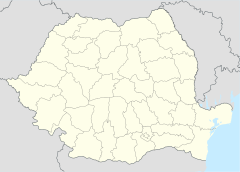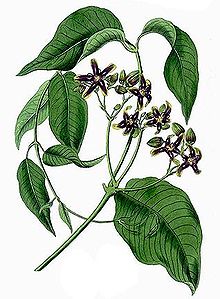Caraorman Forest
| Caraorman Forest Nature Reserve | ||
|---|---|---|
| Location in the Danube Delta | ||
|
|
||
| Location: | Tulcea , Romania | |
| Next city: | Babadag | |
| Surface: | 22.50 km² | |
| Founding: | 1990 | |
The Caraorman Forest ( Romanian Pădurea Caraorman ) is located on the area of the municipality of Crișan , in the County of Tulcea , Romania . In 1990, the subtropical forest was designated as a protected area in nature and landscape protection of the IUCN category IV biotope and species protection area ( forest reserve ) of the Danube Delta Biosphere Reserve .
description
The Caraorman strip of land is a maritime sandbank that lies south of the Sulina arm , has the shape of an isosceles triangle, with the tip at Crişan and the base near the Sfântu-Gheorghe arm . The sandbank is 18 kilometers long, has a maximum width of 8 kilometers and an area of 7,000 hectares, of which 2,250 hectares have been designated as a strictly protected zone. The sandy bottom consists of endless sand dunes that can reach the height of 7 meters and resembles a desert . In the western part of the sandbar is the Caraorman Forest, which is under nature protection.
The Caraorman forest is an oak forest with almost impenetrable bush and partly movable sand dunes, in which, according to legend, the treasures of the pirates are buried. The richness of the vegetation of this forest forms such a dense shadow that it is almost dark in some places. The forest owes its name "Caraorman" to this fact; the name comes from Turkish and means the "black forest".
The village of the same name is also located on the Caraorman sandbank. The village of Caraorman is 3.5 kilometers long and about 500 meters wide and is located on the strip of land between the Sulina and Sfântu Gheorghe arms, 12 kilometers from the municipality of Crișan. The population of the village consists of Ukrainians .
flora
- Climbing plants
The Mediterranean lianas are exceptional .
The Greek tree sling ( periploca graeca ) can reach a length of up to 25 meters, which is unique in Europe. It has its northernmost limit of distribution in the Caraorman forest.
The lianas, together with other climbing plants such as B. the wild grapevine , the ivy , the real hops and the clematis give the Caraorman a subtropical aspect.
- Trees
The trees of the Caraorman Forest include four-hundred-year-old oaks more than 25 meters high, elms , willows , aspens , alders and bog ash , the latter being a botanical rarity.
In the Caraorman Forest, at the point known as "Fântâna Vânătorilor" (German: Jägerbrunnen ), there is the largest oak in the delta. Because of its branches, which also stretch out on the ground, it is called "Kneeling Oak" (Romanian: Stejarul îngenuncheat ). It is 400 years old and 12 meters in circumference.
- Bushes
In addition to poplars, ash trees and oaks, you can also find shrubs in the Caraorman forest, such as Salix , Tamarix and others. a.
fauna
- Birds
Among the birds in the Caraorman Forest, one encounters the white- tailed eagle ( Haliaeetus albicilla ) and the common raven ( Corvus corax ).
See also
- Danube Delta Biosphere Reserve
- Letea Forest
- List of nature reserves in Romania
- List of nature reserves in Tulcea County
Web links
- ddbra.ro , Danube Delta Biosphere Reserve.
Individual evidence
- ↑ rotravel.com ( Memento of March 21, 2012 in the Internet Archive ), The Danube Delta. The sandbanks
- ↑ rundonaudelta.com ( page no longer available , search in web archives ) Info: The link was automatically marked as defective. Please check the link according to the instructions and then remove this notice. , The Danube Delta
- ↑ a b c deltadreamholiday.ro , The Danube Delta
- ↑ ddbra.ro , Danube Delta Biosphere Reserve. Dedicated Zones
- ↑ ddbra.ro , Danube Delta Biosphere Reserve. General data




